Toyota Camry 2011 News

EXCLUSIVE Toyota to get $30m for next Camry
Read the article
By Joshua Dowling · 05 Aug 2013
Toyota Australia will get a $30 million Federal funding boost to go towards production of a new Camry to be introduced in 2015. It means the jobs of 2500 factory workers at Toyota’s car assembly line and engine factories in Altona will likely remain secure until 2017 -- one year after Ford closes its nearby Victorian manufacturing facilities.
The Rudd Government is expected to make the announcement this week. Representatives from Toyota and the Federal Government are yet to confirm the deal.
Contrary to earlier misguided speculation the funding is not to add a third model to Toyota’s Altona factory. Those plans have been put on indefinite hold because of the uncertain future of local car manufacturing.
News Corp understands the extra funding is required because the Camry is due to get a significant update mid-way through its six-year lifecycle.
Customarily, only minor changes are made in the middle of a car’s production life but the Camry has not been selling as well as expected in North America and Toyota has taken the unusual step of approving a complete redesign.
The locally-made Camry is selling well in Australia and its primary export market, the Middle East. However, had Toyota Australia not adopted the new look it would have diminished its export potential because it would, in effect, be continuing with an old model.
Of the three local car manufacturers Toyota Australia receives the least amount of Federal funding and yet employs the most factory workers and builds and exports the most cars by a significant margin. It received $63 million in Federal funds to go towards the $330 million engine factory that was upgraded last year to be compatible with new hybrid technology -- but received no money towards the building of the current generation Camry, released 18 months ago.
Toyota Australia sacked 350 factory workers last year with forced redundancies but hired an extra 168 workers in April on short-term contract so it could match an increase in demand for the Camry in the Middle East.
Toyota exports more than 70 per cent of the cars it makes locally. However, it loses an estimated $2500 on every car it ships because of the strength of the Australian dollar. Toyota Australia balances the books because sales of its imported vehicles are highly profitable.
Toyota’s new funding deal is in addition to a $200 million emergency package to be shared among Toyota, Holden and Ford to make up for the damage caused by changes to Fringe Benefits Tax rules last month. Initial industry forecasts show the FBT will reduce demand for locally-made vehicles by 20 per cent over a full year.
To try to combat that the Federal Government announced overnight it would change the rules of its vehicle purchasing policy to make more Australian-made vehicles eligible. The new “buy Australian” policy will only allow imported cars to be bought by government agencies in extreme exceptions.
This reporter is on Twitter: @JoshuaDowling

Lexus ES cuts ties to Toyota Camry
Read the article
By Paul Gover · 27 May 2013
The new ES is moving up and away from its one-time twin, finally earning a dedicated development program intended to make it a real Lexus and not just a Camry with a posh badge. The ES hits Australia before the end of the year with a two-poweplant plan that includes a hybrid for the first time, and big promises about improvements in every area.
"The decision to develop ES on a different platform came about in the initial development stage, when I drove the previous generations and spoke to potential customers about the things they liked and disliked about ES," the car's chief engineer, Toshio Asahi, reveals to Carsguide from Japan.
"At that early stage of development it became clear that space, refinement and comfort were the priority. But I also knew that dynamic performance needed some attention. To achieve this we engineered a new longer, wider, lower and more-rigid platform - then designed the suspension systems from this solid base."
It's a very different approach to the earlier ES models, which were set as price leaders in Australia. Just over 7000 cars were sold here before the ES was withdrawn in 2006, with 2800 still in known active service. But the car was very similar to the Jaguar X-Type - a re-badged and re-bodied Ford Mondeo - with a loyal group of older owners but few converts.
Lexus Australia lobbied hard to ensure it gets the new ES, driving the right-hand drive program, and also a petrol starter car that's more suitable for luxury buyers than the hybrid CT200h or sporty IS. That points to a price point beyond either the CT or IS, most likely starting beyond $60,000.
"ES will target a very different customer . . . in that ES customers prioritise space, comfort and quietness over driving dynamics," says Asahi. He says a lot of work went into the new ES, just as Lexus has reinvented both the mid-sized GS and compact IS over the past three years to give them more impact and driving enjoyment.
"As for the exterior design . . . it leverages L-finesse design with spindle grille that delivers a resolute look that is distinctive, sporty and elegance. For its interior, ES aims to achieve advanced design incorporating Lexus Remote Touch, while also offering many luxury accents such as wood grain ornaments and leather seats."
"As for driving dynamics, we focused on the improvement of driving comfort, straight-running stability at high speed, while further improving ES’ high levels of quietness." He says the showroom position of the ES is unchanged despite the improved chassis, with the emphasis on luxury.
"When ES was first launched it was called the compact LS, offering many of the features and traits of our flagship vehicle in a smaller body – today that is no different," Asahi says. "Even though it is an entry luxury sedan . . . interior space is comparable to S Class and ride comfort and NVH are key selling points for this vehicle."
News from Japan on the ES comes as Lexus Australia confirms three new models, with the ES 300h and ES 350 opening the action in late 2013, ahead of the GS 300h hybrid in early 2014. “The return of ES to Australia is a direct result of continued customer demand and we are pleased to have secured not one but two options for them while simultaneously expanding our innovative hybrid vehicle portfolio," says the chief executive of Lexus Australia, Sean Hanley.
This reporter is on Twitter: @paulwardgover
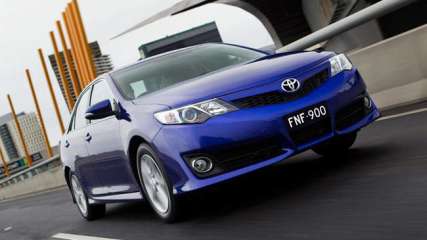
Toyota Camry key to workers' future
Read the article
By Paul Gover · 24 Aug 2011
It's the bedrock of Toyota Australia's manufacturing plan downunder for at least the next five years and goes on sale in November following a global reveal - including Melbourne - this morning.
The seventh-generation Camry is typical of every car that's worn the badge, with safe and conservative looks designed not to offend the buyers in more than 100 countries who will be driving it.
It's a little edgier than the current Camry but the real improvements are promised in everything from cabin space and quietness to fuel economy and emissions.
Biggest news for Australia is a new Camry model - the Atara, which means crown in Jewish and future in Japanese - with a bit more funk thanks to a twin-pipe exhaust and other improvements that were not discussed today.
Also still private today are likely pricing, exact production numbers and the planned export program for the car. But Toyota Australia is confident the new Camry will be good enough to boost output at is Altona factory back over 100,000 cars in 2012. That's still short of the all-time record of 126,000 but a major improvement over the 88,000 production forecast for this year.
"We're about to open a new chapter in the history of Toyota. It's a car that does everything better," trumpets Toyota Australia's head of sales and marketing, Dave Buttner. "We've invested heavily. It is a symbol of Toyota."
Camry has been built in Australia for the past 24 years and it has been the country's favourite medium-sized car for the past 17 years.
Total production has now topped 1.2 million cars and more than 850,000 of those have been shipped overseas.
Buttner says the launch timing for the new Camry is November for the four-cylinder model, the first quarter of 2012 for the Camry hybrid and the second quarter for the V6-powered Aurion. All cars will use engines imported from Japan until a $300 million overhaul of the company's engine factory in Melbourne is complete in the third quarter of next year.
The unveiling today reveals a car with all-new sheetmetal but Toyota Australia is not revealing the car's cabin, which it says has differences from the American interior which is already public.
"There are certain features we would like to leave up our sleeves to excite and titillate you," says Buttner.
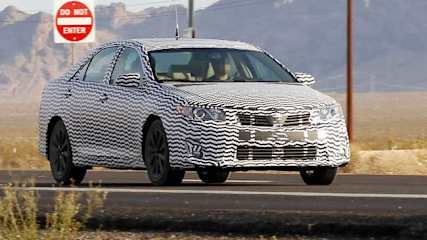
Toyota Camry spy shot
Read the article
By Paul Gover · 04 Aug 2011
...including a drive impression by Paul Pottinger, but Carparazzi got there first with pictures of the Toyota Camry on test in the US.The camouflage makes it tough to pick out the detail but first impressions confirm a move away from the refrigerator-style approach of the past.The angles are sharper and lines tighter and they will be matched by locally tuned suspension for Australia.
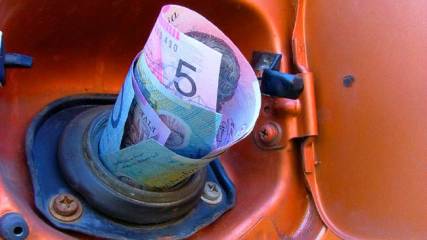
Beat the bowser
Read the article
By Mark Hinchliffe · 19 May 2011
And each week it seems the fuel price sign goes up faster than a politician's pay packet. Australians use a vast amount of fuel in going about their daily business, be it getting the kids to school, travelling to and from work, or conducting the nation's business.Each year we import an ocean of petrol, diesel and LPG that's equivalent to 63,000 Olympic swimming pools. And we're not alone, as the vast populations of newly mobile countries such as India and China take to the roads in their Tatas, Great Walls and Cherys, the world's thirst for oil seems ever more insatiable.Overlay this with war and unrest in the Middle East, the source of 56 per cent of the world's oil, and the inevitable push-pull dynamics of supply and demand can lean to only one thing: higher fuel prices.Here in Australia motorists have been feeling the pinch of higher fuel prices since January when the latest spike in oil prices first began appearing on service station leader boards.The spiralling petrol prices mean fuelling a family car like a Commodore or Falcon now accounts for 2.6 per cent of average weekly earnings. But you don't have to sit back and take it in the hip pocket. There are ways to drive down your weekly fuel bills. Here are a few of them.DOWNSIZING According to VFACTS industry statistics, this seems the most popular choice. Large cars have gone from the top-selling passenger segment in 2000 with 198,766 to the smallest passenger segment last year with 98,583 and falling at 3.1 per cent.Meanwhile, sales of smaller cars are skyrocketing. In the past 10 years small car sales have almost doubled to 239,191 while light cars have increased about 44 per cent to 137,916. You can buy a small car from as little as $11,990 (plus on-road costs) for the Chinese-made Chery, right up $35,990 for a Citroen DS3.And you won't go without. Some of the cheapest little cars these days come with a swag of safety and creature features from multiple airbags to Bluetooth connectivity.PROS: Save on fuel; do the environment a favour; easier to park; nippier in traffic; little hatches can be cavernous if you fold down the rear seats.CONS: You get cramped on long journeys; they are noisier on the highway; they're bumpier over potholes; you could feel a little silly driving a Smurf car.Our Pick: Hyundai i20 (from $15,490) is set to take over from Getz as the segment leader with Euro styling and a high level of features and safety.Others to Consider: Suzuki Swift (from $15,990), Mazda2 (from $15,790) and Toyota Yaris (from $14,990).DIESEL Like smaller car categories, the growth in diesel-powered vehicles is exponential. Since the Federal Chamber of Automotive Industries began collating separate figures for various fuel types in 2005, diesel cars and SUVs have more than doubled to 125,555 last year, which is almost one in every five new passenger cars or SUVs bought today.The reason is that modern diesel engines are not only up to twice as frugal as a petrol vehicle, but they often have lower emissions because they burn less fuel per kilometre and usually have an exhaust system that traps small carbon materials.Modern diesels are also quieter and smoother running. However, diesel engines have higher internal pressures and a complex fuel system so they are more expensive to build than a petrol engine. Some car companies charge up to $10,000 more for a diesel variant, although most charge around an extra $2000.Expensive diesels are often the result of low production volumes and highly technological designs and machining costs. To reap the economic benefits you have to drive big kilometres each year and hold on to the vehicle longer.An extreme example is the Holden CD Cruze auto diesel that costs $4000 more than the petrol model. Based on RACQ's fuel running costs of 9.36c/km for the petrol and 8.41c/km for the diesel, you would have to drive 25,000km for 16 years to recoup the extra cost.PROS: Fuel economy is anywhere between 10-50 per cent better than a petrol equivalent; more torque means quicker acceleration and easier driving around town; better towing capacity; marginally better resale value; lower CO2 emissions per kilometre; diesel engines often last longer because of the more robust engineering.CONS: Fewer diesel pumps on servo forecourts means queuing at the servo; oily bowser pumps leave your hands smelly and dirty; the engines still clatter at idle and sound raucous at full revs; it takes a long time to reap the economic benefits; servicing charges can also be more expensive because of the more expensive oils required and the complicated fuel systems.Our Pick: Fiesta ECOnetic (from $24,990) is a hybrid beater even in stop-start commuting, yet it's a delight to drive.Others to Consider: Hyundai i30 (from $23,090), VW Golf (from $29,990), Subaru Forester (from $35,990).LPG It's almost worth it to convert your petrol or diesel vehicle to LPG just to get the $1500 Federal government subsidy. But you better be quick because the conversion rebate drops to $1250 from July 1 and decreases $250 annually. All rebates and subsidies are only for private vehicles.Conversions cost an average of $2800 for pre-2006 vehicles, but about $4000 for newer vehicles because of emissions regulations. If you buy a vehicle factory fitted for LPG before its first registration, you get a $2000 rebate from the Feds.However, choices of new vehicles with factory fitted LPG systems are limited. Ford has a new LPG Falcon coming in July and has factory-fitted systems for some of its utes. Holden has an Autogas dual-fuel injection system for its Commodore and will have a mono-fuel LPG Commodore later this year.Toyota has a direct injection LPG system for its 2.7-litre HiAce vans and Mitsubishi has an aftermarket sequential multi-port direct-injection system for its Challenger, Express Van, Pajero, Triton and the now defunct 380.PROS: Much cheaper fuel (about 60c compared with $140+ for ULP); government subsidies make conversion attractive; LPG prices are fairly static so you don't have to fill up on a Tuesday morning when servo prices are cheapest; lower emissions.CONS: Limited choice of new dual-fuel vehicles; only suitable for large vehicles; you lose boot space; even though they are safe they can develop minor smelly leaks; they add about 75kg (about the weight of two large suitcases) to the rear of the car effecting handling; it can be difficult finding servos with LPG in rural areas.HYBRID These are vehicles with petrol or diesel internal combustion engines paired with an electric motor or motors. The drivetrain and associated battery pack for the electric motor is more complex so therefore more costly. Like diesels, you need to do big kays before the savings at the bowser recoup the extra purchase price.For example, a Toyota Prius costs about $2500 more than a Corolla Ultima. Using RACQ's running costs, the fuel savings will take 4 years at 15,000km a year (or 2.5 years at 25,000km/year) to recoup the extra purchase price.Most hybrids switch off totally every time you stop and run on electric power only when you are driving slowly, so they are most economical in heavy traffic. The benefits are marginal on country roads and highways, although when both drive units are operating under heavy acceleration such as when overtaking, they do offer a tangible boost to acceleration.Despite the fact the technology has been around for 10 years, Hybrids are still relatively new. Today, there are 10 hybrid models on the market, but only the Toyota Prius, Camry, Honda Insight and Civic are affordable.Hybrids tend to be bought mainly by governments and big business to emphasise their green credentials. Taxi companies also like hybrids because of their fuel efficiency in urban environments. If you're open to the idea of a used vehicle, then a second-hand Prius or similar is a reasonable option.PROS: Cheaper to run in traffic; feel and be seen to be environmentally conscious; extra power under heavy acceleration; almost silent running when on electric only power.CONS: Higher purchase price; the number of models is limited but you can choose from a small Prius to a large Porsche Cayenne SUV; some look odd like the Prius and Insight.Our Pick: Toyota Prius (from $39,900) and the Honda Insight (from $29,990) at least look like futuristic hybrids, so your neighbours will know you are trying to be green.Others to consider: Honda Civic (from $34,490), Toyota Camry (from $36,990)ELECTRIC CARSThe only production electric cars in Australia are the Tesla Roadster at $241,938 and the Mitsubishi i-MiEV which is available only on a lease of $1740 a month for three years for a total of $62,640. Then the car goes back to Mitsubishi. When it arrives it is expected to cost $70,000.However, prices will come crashing down in the next few years as more and more EVs become available in Australia. The first of these will be the Nissan Leaf and Holden Volt next year.The Volt is expected to cost less than $40,000 and Nissan is saying the Leaf will cost about the same to run as a Tiida, even though initial outlay will probably be close to the Volt. While tailpipe emissions are zero, most electricity in Australia comes from burning dirty coal, so the environmental advantage is reduced.Some critics say there is no advantage. Current limitations of battery technology mean range is also limited to about 160km according to the car companies, but in real life it's less, especially if you have a lead foot.PROS: Very cheap to run; no tailpipe emissions; almost silent running; aerodynamic body shapes.CONS: Expensive to buy - that's if you can find one to buy; silent running can be dangerous for pedestrians; battery disposal is an environmental issue; range is limited; long re-charging time (up to eight hours); most EVs are designed to look futuristic but just end up looking like golf carts.DRIVE ECONOMICALLYOf all the things you can do to drive down your fuel bill, this is the most pragmatic as it's the simplest and most affordable. It can be expensive to swap your trusted and much-loved family car or SUV for something smaller or with an alternative powertrain.Trade-in prices on family cars are down according to the Motor Trades Association and if you buy a new car, you are up for dealer delivery charges, stamp duty and registration. It may be cheaper to hang on to your vehicle, but modify your driving behaviour for more economical running.There are many simple things you can do: Plan trips better and make fewer trips; jettison excess weight from the car; correctly inflate your tyres and get your car serviced more frequently.Most importantly you can vary your driving behaviour by slowing down, changing up the gears sooner, avoiding heavy breaking and staying away from peak-hour traffic. You may have heard these all before, but here are five radical ideas to reducing your fuel expense burden that you may not have heard.1. Cool idea: Turning off the airconditioning will provide a slight increase in fuel economy. However, when travelling on the highway, it is more fuel efficient to have the windows up and aircon switched on than having the windows down creating aerodynamic drag. Don't leave the aircon off for long periods as bacteria will build up in the system.2. Light is right: So throw out not only the unnecessary baggage such as your golf clubs, but maybe also the spare tyre. It can weigh 15-20kg in the average car. The US Department of Energy quotes fuel use as 1-2 per cent for every 45.5kg, so that's at least 0.5 per cent saved. Conversely, NRMA tests show that loading a vehicle to its rated maximum increases fuel consumption 24 per cent. While you might be able to get away without a spare tyre around town, we recommend you always carry it on long trips, especially in the country.3. Turned off: Switch off the engine at long traffic light stops. Modern fuel-injected cars start quickly without the need for any throttle. Car makers with stop-start technology that automatically switches off the engine every time the car is stopped quote fuel savings in traffic of 4-5 per cent.4. Just cruising: Use cruise control more frequently. Most cruise control systems actually put the car's engine into an economy mode and will run more efficiently than most drivers can drive as it accelerates more evenly. It is best used on the open road and not hilly terrain or stop-start conditions. While we could not find any official figures, some sources claim fuel savings up to 14 per cent.5. Re-tyre: the next time you buy tyres, choose from the new range of "eco" tyres with low rolling resistance. A California Energy Commission study estimated low-rolling resistance tyres could save 1.5-4.5 per cent on fuel consumption.

This year looks like a boomer in Aussie motoring
Read the article
By Paul Gover · 06 Jan 2011
All the signs are positive after a strong run through 2010 on everything from new models and new technology to the price of cars and petrol and even motorsport.Last year produced a million-plus result in showrooms, only the third on record and a huge turnover in a country with a population of just over 22 million people. And the sales total for 2011 is likely to be even bigger.The fuel for the sales growth will come, as usual, from the importance of cars in Australia and the incredible number of new models that his showrooms each year. No-one can underestimate the sense of freedom that Australians tap with their cars, or the genuine needs of people who rely on cars for everything from day-to-day commuting to long-distance nomadic work.Car companies are currently doing all they can to clear their backlog of 2010 stock in readiness for the first arrivals of 2011, which means great buying for at least another month. Cars are like horses, because they all get a year older on the same day, and anything in a showroom now with a 2010 build date is out-of-date.But there is nothing out-of-date about the lineup for the first major motoring event of the year, the North American International Auto Show in Detroit. It opens next week with the unveiling of everything from a Hyundai Veloster and the next Honda Civic to a new Porsche supercar.There will be lots of news from Detroit, perhaps including Holden's plans to revive Commodore exports to the USA and the potential future of the Ford Falcon. Chrysler will show its new 300C, which will take more than a year to reach Australia, and Chinese brands are promising another new wave of technology and small cars.Chinese cars will be one of the big stories in Australia in 2011, with Chery, Geely and Great Wall all planning to start passenger car sales down under. Great Wall is already doing well with its value-priced utes and SUVs but it's Chery that is looking for the big breakthrough with baby cars that undercut the Korean price leaders.On the motorsport front, the Dakar Rally is already blazing through South America - with Bruce Garland doing his best for Australia in an Isuzu D-Max - the V8 Supercar championship will be another boomer, and Mark Webber will be looking to improve on his 2011 season in another year with Red Bull Racing.Melbourne will be motoring central again this year, not just because it is home to the three local carmakers - Holden, which has the local Cruze this year; Ford, which is about to go with the updated Territory; and Toyota, which has an all-new Camry for 2011 - but also thanks to everything from the Australian Grand Prix to the latest running of the Australian International Motor Show.The organisers of the show have confirmed this year's dates as July 1-10, with the promise of a truly world-class event. Moving the date is planning to bring more people indoors to look at the shiny new metal and, more importantly, open up a new position on the global motoring calendar to allow the Australian show to become a major Asian motoring event each year.
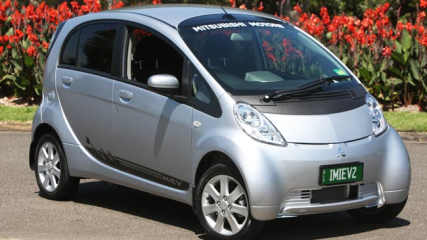
From little green things...
Read the article
By Paul Gover · 09 Sep 2010
It's a motor show, but not the way we've ever known them in the past. This one is limited to just 17 cars.The reason why there are so few cars involved is that they must all be green cars. And that's the reason it has such a big future.As time passes, and carmakers expand their green fleets with all sorts of lean-burn petrol engines, high-tech diesels, hybrids and electric cars, the Green Zone Drive promises to become a significant event for people who want to change their motoring priorities.The event is the idea of a couple of motor industry veterans led by John Kananghinis, formerly a public relations chief and marketing boss at BMW Australia. It's not just a stand-and-look show, either.The idea behind the Green Zone Drive is to have people get behind the wheel and actually drive the cars, around a special circuit laid out in the centre of Melbourne. It's claimed as a world first and a major innovation in green motoring.The event has picked up a lot of backing, from the Victorian government and Melbourne city council to EPA Victoria, Future Climate Australia, Shell and even the driver training experts at Murcotts. Nine carmakers are involved, which is not very many with more than 50 brands on sale in Australia today.But the number is sure to grow and the current list - Audi, BMW, Citroen, Ford, Hyundai, Mini, Mitsubishi, Toyota and Volvo - shows a good spread across sizes, prices and classes.The obvious hero car is the first plug-in electric car on sale in Australia, the Mitsubishi iMiEV. But the spread of cars runs from the locally-made Toyota Camry hybrid to the Volvo C30 DRIVe, the super-economy Ford Fiest ECOnetic and a range of diesels wearing Audi, BMW, Mini and even Hyundai badges.Of course, the Toyota Prius is also there. The course for the drive takes green car fans around Melbourne's Docklands region and its no coincidence that it starts and finishes outside the Fox Classic Car Collection, home to one of Australia's best lineups of landmark cars.The event runs for just eight days but it's a start and has obvious potential to expand in coming years, not just in the car lineup but also its location. It could easily go on an Australia-wide tour and perhaps even head overseas.If you want to know more, take a look at www.greenzonedrive.com.au
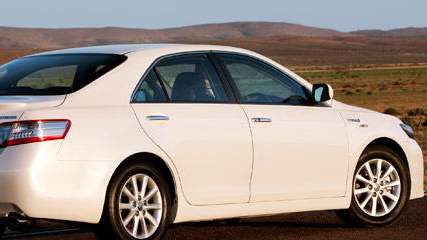
Camry our first green car
Read the article
By Paul Gover · 08 Feb 2010
That's the showroom tag for the Toyota Camry hybrid, which finally hits the road today. The hybrid is being pitched as the flagship in the Camry range, from the way it looks to a cabin that is claimed to set a new standard for quietness in a locally-made car.
The hybrid bottom line is fuel economy of 6 litres/100km, with performance that trims a full second from the petrol-powered Camry's 0-100km/h time. The $36,990 pricetag compares to $29,990 for a basic Camry Altise, or $39,990 for a Prius hybrid.
The basic details of the Camry hybrid have been public since the car was introduced in 2006 in the USA, but there has been a lot of work on 'Australianising' the car, both for production and driving. "Right from day one we knew that the American version wasn't going to work," says Phil King, who headed local chassis tuning work.
The result is a car which is more responsive, as well as packing a full suite of safety gear. The Camry hybrid picks up the vast majority of its mechanical package from the third-generation Prius, which went on sale last year, although it has a 2.4-litre engine (up from 1.8) and still has a drive belt for the water pump, unlike the Prius.
Full details of the pricing, equipment and sales plan will be revealed later today. But Toyota Australia is already trumpeting six airbags, ESP stability control, active steering assistance and a special power cut-off. But the boot has taken a hit to fit the onboard battery system.
"This hybrid can walk, and chew gum," says Peter Evans, technical chief for Toyota's imported cars. More details later, together with a first driving impression.
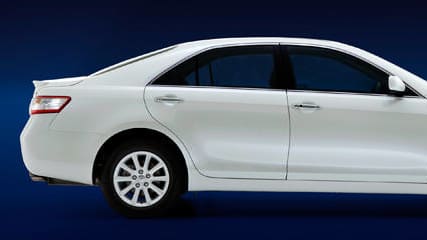
Toyota Camry hybrid hits sixes
Read the article
By Neil McDonald · 03 Feb 2010
As momentum builds for Toyota's newest green machine, it has released fuel economy figures that show the hybrid Camry will achieve a combined fuel economy figure ‘in the low 6.0-litres per 100km range’.
Despite being about 70kg heavier than the petrol Camry, the hybrid is tipped to be the most fuel efficient locally built car in the country. The equivalent petrol four-cylinder Camry delivers 8.8 litres/100km. Toyota says that compared to its bigger, locally-built six-cylinder rivals, the hybrid is expected to save at least 1100 litres of fuel in a year of city driving.
Toyota's corporate manager of product planning, Peter Evans, expects the car's fuel consumption and emissions to rival many small and compact cars. Evans says motorists could save at least 1100 litres or $1320 in a year of city driving with the hybrid.
This is based on a metro pump price of $1.20 a litre for regular unleaded petrol. Fleets operating more than several vehicles stand to save far more, he says. Servicing costs will be the same as the petrol version.
Hybrid Camry owners will pay $130 for up to four standard scheduled services during the first three years or 60,000km. The hybrid will be powered by a 2.4-litre four cylinder and electric motor developing about 140kW and mated to a continuously variable transmission. Apart from economy, the hybrid will emit less than 150 g/km of greenhouse gases.
Although it is built at Altona, the car's hybrid components come from Japan. Much of the car has been locally re-engineered for Australian driving styles, ride and handling expectations.
Although it looks similar to the petrol car, it gets a sleeker underbody and other aerodynamic aids to maximise fuel economy at highway speeds. Toyota Style Australia senior designer, Paul Beranger, says the car's design is an amalgamation of the global car with local tastes, particularly with the interior.
He says it must communicate the advance technology without alienating buyers "from the face that Camry represents". "We are integrating mainstream with new technology," he says. "We have to ensure that the car appeals to existing owners as well as early adopters."
Extensive local research by Toyota shows that customers interested in hybrids were aware of that technology, he says. Toyota plans to sell 10,000 hybrid Camrys in the first year, with many going to governments and fleets but it is also targeted at families. It goes on sale within a month, with a entry price around $33,000.Economy wars
Holden Commodore 3.0 V6 six-speed - 9.3 litres/100km, 221g/km C02. 5.5 greenhouse rating Ford Falcon XT six-cylinder six-speed - 9.9 litres/100km 236g/km C02. 5.5 greenhouse rating Toyota Aurion V6 six-speed - 9.9 litres/100km 233g/km C02. 5.5 greenhouse rating
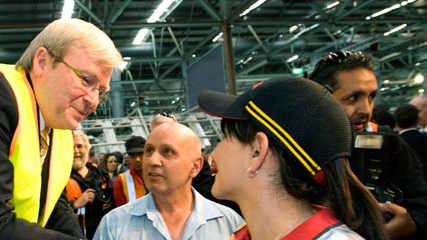
Toyota may push Aussie exports
Read the article
By Paul Gover · 17 Dec 2009
The upcoming Camry hybrid is an obvious prospect for overseas sales, with New Zealand already committed, but the real key for Australia is everything from car parts to engineering brains and design skills.
Toyota believes local brainpower could help fuel its growth in the Asian region over the next 10 years with many emerging economies linked through a re-organisation that puts Australia into the same region as China and India. "Australia is very much in a strategic position for this growth belt for automotive," said Yukitoshi Funo, one of only five executive vice- presidents of global Toyota, during a flying visit to celebrate production of the first petrol-electric Camry at Altona in Melbourne.
"Australia is very much strategically well positioned in terms of taking advantage of this growth belt. That is China, Asia, India, the Middle East and even Africa. Australia is not an amateur, if you like, in terms of doing exports for other destinations." But Funo stopped well short of pushing for more Camry exports and said Toyota Australia had other possibilities which would also be open to other local companies, including component makers, in coming years.
"How to integrate this automotive industry with those Asian neighbours is the key question. What is the advantage, what is the weakness, what is the area that should learn more? These are the issues that the Australian automotive industry should address," he said, before focussing on Toyota Australia.
"We have to look at Camry, we have to look at other models, we have to look at components, we have to look at components in components. Like, for example, to reduce the Yen component. "Of course, there are other areas. Like we have engineering units here. They could do organise a closer relationship with sister organisations located in Bangkok."
This would be a similar approach to the one which has worked successfully for both GM Holden and Ford in Australia. Ford has done a number of regional development programs, including two small cars for India and a pick-up for Asia, while Holden engineered and developed the Chevrolet Camaro which is now built in North America.
Toyota Style Australia, run under the direction of Paul Beranger, is already linked into Toyota's global design process and the company makes extensive use of proving ground facilities at Anglesee near Melbourne. Toyota is hopeful that its exports to the Middle East will rebound in 2010 after a major slump this year which has cut output at Altona from a peak of 148,000 to around 110,000 cars.
But, with just 10,000 hybrid Camrys on the books for next year, it is unlikely to be more than a trickle feed to any customers outside the country until at least 2011. Funo also outlined a program to try and make Australia the first 'currency free' operation inside Toyota, removing the peaks and troughs of exchange rate fluctuations that make it so tough to do business as both the country's biggest automotive importer and exporter.
"This company exports many, many cars to other destinations like the Middle East. But at the same time we import many. "I think if we apply a little bit more aggressive effort in terms of the exports, or reducing the currency, or something like that, from Japan to a weaker currency. By doing that we can maybe make Australia the first currency-free operation in the world for Toyota."
"We can expect some counter-measures ... if you want to call it that, with development of small cars and suchlike."




